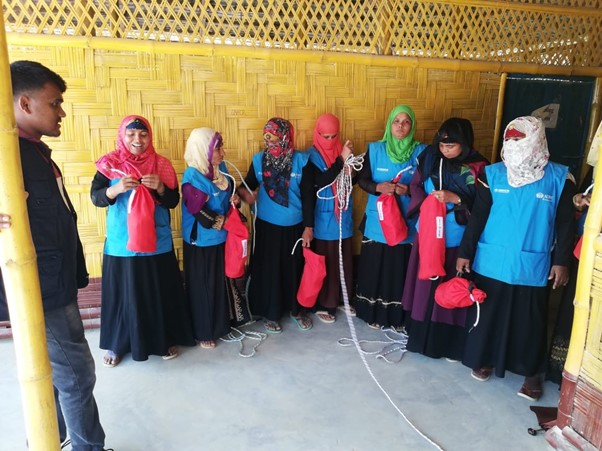Women and Disasters
On average, disasters have killed more that 70,000 people and affected more than 200 million per year in the Asia-Pacific region alone. While this is an extremely disaster-prone area, ecosystem degradation and climate change have exasperated the frequency and scale of disasters globally, and the number of people impacted by climate-related disasters continues to increase. While climate related disasters themselves do not discriminate, their impacts are felt differently due to people’s socio-economic status and the impact of intersecting oppressive systems of governance and economy which breed unequal access to opportunities. Pre-existing gender inequalities are often magnified in contexts of instability and as a consequence, women can suffer disproportionally when disasters occur.
Men and women can be affected differently by the same external event even within the same household, due to the gendered activities which can occur at this level. This can be a challenge for practitioners in the Disaster Risk Reduction (DRR) field as collected data regarding the impacts of disasters rarely analyse household level discrepancies in experience and thus the unique needs of women in these contexts can be overlooked. For example, after the New Orleans floods, 80% of the people left after the mandatory evacuations were women, while they made up 54% of the population. In these situations, women are often the caregivers remaining on site to support the sick and injured, and often remain more local to the disaster-hit area in the immediate aftermath. Women’s reproductive and maternal needs can also pose a unique challenge in a post-disaster setting. With damaged health facilities and disrupted infrastructure, women’s services can be severely impacted and access to feminine hygiene products and contraception can often be neglected as secondary healthcare becomes supplementary. Furthermore, when family income is severed due to crises, it is often the young girls in the family who are pulled from their education to provide additional support at home and/or support the family’s finances. An analysis of the impact of drought conditions in Uganda showed that a 15% decrease in rainfall resulted in a 5% decrease in girl’s enrolment in elementary schools, while no effect was found for boys. Sexual and Intimate Partner Violence (IPV) often increases after a disaster, disaster trauma can heighten aggressive behaviour and exploitative systems like human trafficking can more easily be established in volatile conditions. Women can be particularly vulnerable to these contexts as their livelihoods and home conditions destabilise. These are just some examples of how women can face complex obstacles when responding to disasters.
Women as Agents of Change
While women and girls face disparate disaster risks, they can also be key agents for change. They bring unique and essential knowledge, skills and experiences that can inform effective Disaster Risk Reduction processes. However, until we create integrated platforms for women’s voices and develop funding pools to support their development, their capacities may remain overlooked on an international scale. We must let the international be informed by the local, and work against historic development practices which prioritise ‘experts’ over local knowledge bases. Over the last decade, in response to the UN Sustainable Development Goals, there have been a range of normative commitments to advancing gender responsive DRR practices. However, little attention has been given to the structural inequalities which continue to undermine recovery after disasters to ensure that women’s empowerment is prioritised. The task at hand may seem overwhelming on a global scale, but there have been extremely active women’s platforms which have really engaged with this issue and who are working to create meaningful change, particularly in the Pacific region. The Shifting the Power Coalition (StPC) was established in 2016 to create a collective power base work women to shape ‘inclusive responses to natural disasters and climate change.’ The coalition extends to 100,000 women across the Pacific islands, and it follows a partnership and collaboration model that mobilises small networks of women and community leaders so that they can share ideas and practices for rights based DRR and response. The coalition has created a safe and intergenerational space for women to design and deliver new practices. A core ethos of the women’s networks is ensuring that people are not left behind, this means providing needs-based recommendations for the security of LGBTQI survivors and the inclusion of those living with a disability. The networks take an intersectional approach to evaluating response planning which sets a very inclusive space and urges Pacific leaders to address inequalities in provisions. This is reflective of wider women’s networks and women’s activism which have started to shape and change DRR practices. However, there is a lack of budgetary resources and prominent political advocacy to really influence policies at a national and international level. While Civil Society groups have been given more involvement in policy implementation, this does not go far enough as we need more strategic collaboration between institutions.
Investing in women is an effective means to advance sustainable development and respond to climate change. Women are active members of society, and their needs and interests must be better supported in development spaces. In the past, women have been generally absent in the development of resilience strategies in the NGO world. MOAS is dedicated to ensuring women do have a central role in DRR planning and practice. Our DRR programme in refugee camps aims at mitigating the risks of flooding and fire, we readily engage women in the training so ensure their leadership roles are strengthened. We translate commitments to women’s inclusion into real growth, by shaping gender sensitive training tools and creating a safe and respectful space in the camps for women to be active members of DRR training.
If you are interested in the work of MOAS and our partners, please follow us on social media, sign up to our newsletter and share our content. You can also reach out to us any time via [email protected]. If you want to support our operations, please give what you can at www.moas.eu/donate.

